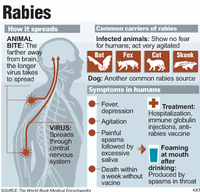

Rabies Can Be Deadly!!
Rabies is a virus that may affect the brain and spinal cord of all mammals, including dogs, cats and humans. Although it is preventable, there is good reason that the word “rabies” evokes fear in people.
Annually, rabies causes the deaths of more than 50,000 humans and millions of animals worldwide.It is nearly always deadly if not treated before symptoms begin. Once symptoms of rabies appear, the disease results in fatality.
People usually get rabies when a rabid animal (animal with rabies) bites them. People in the U.S. are
most likely to get rabies from, bat, dog, ferret and cat bites. Bats, raccoons, skunks, foxes and coyotes are the animals most likely to have rabies in the U.S..
The rabies virus can spread to pets, such as dogs, cats and ferrrets. But household pets rarely get rabies, because most of them get rabies vaccines. Pets that stay indoors are very unlikely to get rabies.
Note: Small mammals such as mice and squirrels almost never have rabies.
It's possible to get rabies even when you don't see an animal bite. For example, bat bites or scratches may be so small that you don't notice them. If you or your children come in direct contact with a bat, or if you find a bat in a closed room with a sleeping person, call your doctor right away.
People also can get rabies by handling animals with rabies or inhalng the virus, but these cases are rare.
What are the symptoms of rabies?
Signs of rabies in animals may include drooling, foamng at the mouth, or paralysis. A pet with rabies also may behave differently than usual, such as actng shy when the pet is usually friendly. A wild animal with rabies may have no fear of humans.
Rabies in humans begins with symptoms such as fever, cough, or sore throat. Later, systoms become more serious and can include restlessness, hallucinations, and seizures. The final stage is coma and death.
If you think you've been exposed to the rabies virus, it's very important to get medical care before symptoms begin. If symptoms appear, it's too late for a cure, and the infection will probably lead to death.
The time from exposure to the virus until symptoms appear usually is 2 to 3 months. in rare cases, it may be shorter or much longer.
IN ENNIS...
Each year in Ennis, there are numerous reported cases of people being injured by domestic and non-domesticated animals. Through the enforcement of state and local laws, the Health Department Animal Control Officers ( ACO’s) works diligently with responsible pet owners to prevent animal bites and scratches to humans. In the U.S. hundreds of people are injured each year by at-large pets; many are children who see a stray animal and approach it in an effort to provide help. This is just one of the reasons ACO’s enforce the animal containment provisions of the Code as strictly as possible. This is geared towards informing the public as to the procedures that are followed when a bite occurs and what actions must be taken to insure that the animal does not have a communicable disease.
ALL instances of animals injuring a human is required by State Law to be reported to the Local Rabies Control Authority within the City.
When an animal causes an injury to a person that is capable of allowing the rabies virus to be transmitted, the animal must be placed in quarantine by the City for a period of ten (10) days from the time of the bite or scratch in accordance with the State Law. Quarantine can be done in either a state-approved quarantine facility or at the owner’s home in certain situations and provided that all state and local requirements are met.
If bitten please contact the Health Department between 8:00 a.m. and 5:00 p.m. Monday through Friday at 972.875.1234 or visit our office at 500 Lake Bardwell Drive Ennis, Texas 75120. After hours contact the Ennis Police Department at 911 .
Disposition of Domestic Animals Exposed to Rabies
Sometimes, domestic animals such as dogs or cats may come in contact with or may have been bitten or scratched by a known carrier of rabies such as a skunk, bat, coyote, fox or raccoon. Texas law states that, all dogs and cats that have been bitten by, directly exposed by physical contact with, or directly exposed to the fresh tissues of a rabid animal shall be euthanized; or immediately vaccinated for rabies, placed into confinement for a period of 90 days and given a booster at the third and eighth weeks of confinement if the animal is NOT currently vaccinated for rabies. If the animal is currently vaccinated for rabies the animal shall be euthanized or immediately given a booster rabies vaccination and placed in confinement for 45 days. If your animal is vaccinated for rabies, please be ready to present a current rabies vaccination certificate from a licensed veterinarian to animal control. A rabies tag is not valid proof that your animal has been vaccinated against rabies.
NOTE: All dogs and cats at least 4 months of age are required by law to be vaccinated against rabies. Rabies vaccinations must be administered by a veternarian at any vet or wellness clinic, and current vaccination records will need to be provided to the Department upon request.
If you or your animal has been exposed to rabies in any way, please contact the Department of Health Services immediately by dialing 972-872-1234 M-F 8a.m -5p.m. Email . For after hour emergencies contact the City of Ennis Police Department at 911. Do not attempt to approach, capture or kill any wild animal suspected of carrying rabies.
Preventing the Spread of Rabies
Be a responsible pet owner:
Additional Rabies Resources:
Download the Bats & Rabies Public Health Guide
Download the Bats in Schools Poster
When Should I Seek Medical Attention?
